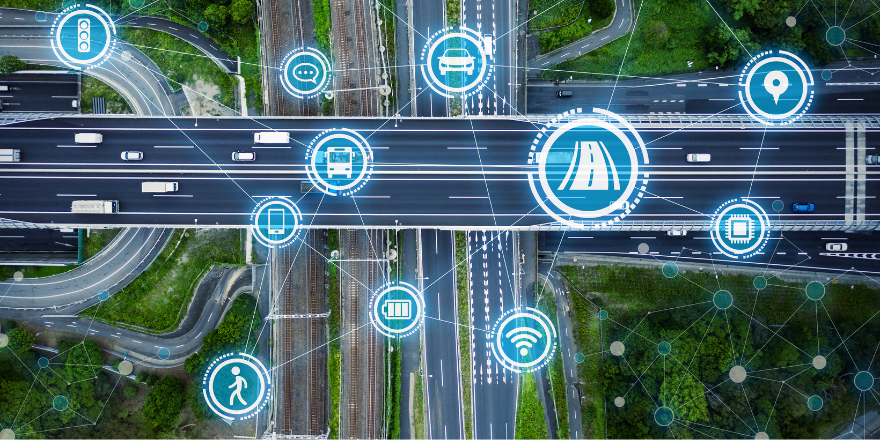It’s a fact that safe, efficient student transportation programs are built on the expertise and commitment of exceptional team members. There’s a place for technology in the mix as well, giving hard-working drivers, dispatchers, and technicians tools that support safety and efficiency. Here are six ways innovative technology is transforming the traditional yellow school bus.
GPS & AI-enabled tracking
GPS (Global Positioning System) technology has transformed the day-to-day operation of school buses nationwide. Now, we are seeing more integration of AI systems into GPS technology. Here’s how they combine to provide safer student transportation:
Real-time monitoring
GPS tracking provides student transportation contractors, school administrators, and parents with real-time information about the locations of buses. This allows for more accurate estimates of arrival and drop-off times, enhancing student safety.
Emergency response
GPS also helps ensure buses are following designated routes and adhering to schedules. In the event of an emergency or deviation from a planned route, dispatchers or transportation directors can geolocate a bus with pinpoint accuracy and take appropriate action. AI-assisted GPS information can be crucial for emergency responders as well, allowing them to find the least congested route to locate a bus if something goes wrong.
Route optimization
Data provided by GPS can be used to optimize bus routes by analyzing factors such as peak traffic congestion. Artificial intelligence algorithms are now being employed alongside GPS technology to analyze and calculate the best possible route for every bus. By identifying the most efficient pathways, contractors can maximize fuel efficiency, minimize delays, and ensure smoother journeys for students.
Transparency
GPS tracking allows operators to assess driver performance to determine if additional training is necessary. It also enables parent communication features such as mobile apps or web portals. These systems allow parents to see where their children’s buses are in real time, building even greater transparency – and trust – into each bus ride.
Wireless internet on buses
Some states are introducing legislation requiring buses to be internet capable, not only to address student inequities (rural and McKinney Vento students who spend more time on the bus need internet connectivity to complete homework assignments), but also to increase safety. Here is how WiFi can be an important component in transportation safety:
Communication
GPS tracking provides parents and transportation operators with real-time location data, but there is often a critical need for immediate communication. More and more districts are equipping their buses with 4G or 5G wireless internet connectivity, precisely for instances like these. In rural areas where standard cell service may be lacking or not powerful enough, WiFi is necessary for drivers to communicate immediate concerns to emergency services or school personnel.
Emergency response
In the case of an emergency, internet equipped buses have the benefit of being able to contact authorities no matter where the emergency occurs – in some cases with just the touch of a button.
Monitoring
Onboard cameras provide necessary transparency and documentation of both driver and student behavior, and WiFi allows that information to be live streamed directly to districts for faster responses to safety incidents.
AI-enhanced telematics
Telematics refers to the integration of telecommunications and information technology into vehicles, recording and sharing data about drivers and vehicle behavior. Here’s how telematics, aided by AI, can promote safety:
Encourage safer driving
Telematics can collect information on various aspects of driver behavior, including speed, rapid acceleration, braking patterns, and adherence to traffic rules. AI is now able to efficiently analyze the data collected by telematics, highlight patterns, and offer valuable insights. All of this allows student transportation contractors to provide feedback to drivers, either by rewarding appropriate driving habits or by pointing out areas for improvement.
By identifying safer driving habits, telematics systems contribute to an overall reduced risk of accidents and better safety on the road. The information captured by telematics also can assist in accident investigations, giving safe drivers an important “backup” if an accident happens.
Maintenance monitoring
Telematics can monitor the health and performance of school bus engines, brakes, and electrical systems as well. Interconnected sensors collect data on factors like fluid levels or tire pressure, identifying areas for maintenance before they become problematic. AI is only making these tools more powerful by incorporating machine learning to predict when parts need replacing.
This proactive approach reduces the chance of an unexpected breakdown or malfunction that could compromise safety.
Door entry sensors
Door entry sensors are designed to detect when the bus doors open or close, helping ensure the safety of students when boarding or exiting the bus.
Some sensors include features like anti-pinch technology, which can detect if the door is trying to close on an object or child. If an obstruction is detected, the sensors can engage doors to either automatically reopen or stop closing, minimizing the potential for accident or injury.
Cameras, inside and out
It’s increasingly common for school buses to be equipped with digital cameras, mounted either inside or outside of the vehicles. Here’s how they can enhance safety for drivers and students:
Monitoring behavior
Interior cameras help monitor student and driver behavior, encouraging a safer, more orderly environment. If issues with misconduct, bullying, or other inappropriate behaviors arise, the footage captured by a digital camera can help determine the cause of an incident and assist in resolving any disputes that may arise. AI algorithms can also analyze footage and identify patterns in student behavior that can cue officials when they may need to step in.
Eliminating blind spots
Drivers will attest to the effectiveness of the many, many mirrors affixed to school buses. Cameras, however, provide an enhanced view for drivers, highlighting areas outside the bus like the “danger zone,” reducing the risk of accidents, and supporting a safer ride for everyone.
Stop arm violation detection
Some school buses are equipped with external cameras specifically aimed at monitoring stop arm violations, like the systems provided by BusPatrol. These cameras capture footage of vehicles that illegally pass a school bus while the stop arm is deployed and the red lights are flashing. The recorded evidence can be used to hold violators accountable, helping to protect students and even earn revenue for the school district.
It’s important to note that the use of cameras on school buses may be subject to varying privacy regulations and policies. Schools and districts typically establish guidelines for camera usage to ensure that the privacy rights of students and staff are respected while maintaining a safe and secure transportation environment.
RFID and smart cards
The use of student ID cards with computer chips for safer operation of school buses is becoming more and more common. These IDs, often referred to as smart cards or RFID (Radio Frequency Identification) cards, can offer several benefits:
Efficiency
RFID cards can be used to provide detailed information about student boarding and exiting patterns on buses. This data then can be used to optimize routing for more efficient transportation programs.
Student safety
ID cards can be scanned to help ensure students board the correct buses and disembark at the right stops, keeping them safer. And because only students with valid ID cards can board the bus, this technology reduces the chances of an unauthorized individual gaining access to a vehicle.
Districts can even integrate the data collected by RFID cards into automated attendance management systems. This is particularly useful for districts with large student bodies or those serving broad geographic areas.
Contact us
If you’re interested in how technology could benefit your student transportation business, reach out to us. We’re ready to build a pathway to partnership.
American Student Transportation Partners (ASTP) is a national network of reliable student transportation providers. We’re driving the future of student transportation by providing access to education through safe, reliable student transportation programs. Exceptional bus operators choose ASTP because of our innovative approach to partnership, as well as the resources we provide to help “future-proof” their operations.
To learn more about partnering with ASTP, contact Nick Tierno, Director of Corporate Development, at ntierno@astpartners.com.

